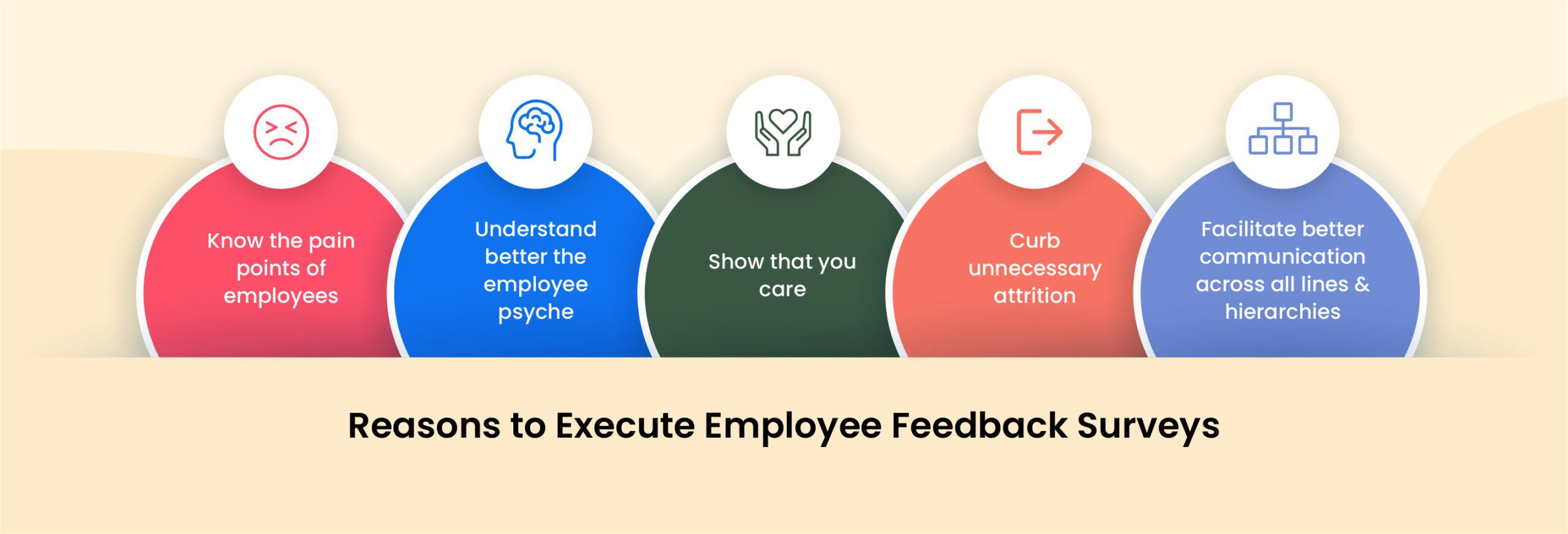Feedback is important; especially when it comes from your employees. Employee feedback surveys don’t just help improve their experience at a company, but also the overall business by providing insights on what can be better to grow faster.
With the help of smart tools, most companies have automated their employee surveys. But the problem lies in putting the data to work.
In this article, we’re going to briefly talk about what employee feedback surveys are, why they are important and how to use the different types of surveys.
What are employee feedback surveys and why are they important?

An employee feedback survey is essentially feedback from the employees of a company, on the organization they are working in.
Employee feedback surveys are directed towards improving the overall growth of your organization by understanding what do employees think about the organization’s vision, mission, goals, processes and other aspects, both on short-term and long-term levels.
These feedbacks can have different goals themselves, but mostly are directed towards ensuring that the individual employee’s goals are aligned with that of the organization. Employee feedback surveys act like customer surveys, the only difference is that the target audience is known and lies internally this time, i.e. your employees.
To put it in a concise manner, following are some of the reasons why employee feedback surveys are important for an organization:
- It helps you know the pain points of the employees and their respective projects, managers, teams, etc
- Surveys are a great way to understand the employee psyche and increase employee engagement
- Periodic employee feedback surveys show that you care, enhancing the employee experience
- Conductive regular surveys helps keep employee woes in check and increases their productivity, at the same time curbing unnecessary attrition
- Last but not the least, employee surveys help ease and facilitate better communication across all the lines and hierarchies
Employee surveys can bring you actionables in different forms, depending on the type of survey you conduct. So let’s take a quick look at how you can put different types of employee feedback surveys to work.
How can you use different types of employee feedback surveys?
To understand how to use the data from surveys, you need to understand the different types as well. So in this section, we will introduce you to each type and tell you more about how to use that survey in the best way possible.
#1 Employee Engagement Surveys
The first employee feedback survey to address would be the one that helps increase engagement. Employee engagement refers to how engaged or involved an employee feels when it comes to the organization. This refers to a complete 360-degree engagement, from syncing their individual goals to that of the organization, to the work that they do.
Employee engagement surveys help understand whether or not the employees are engaged, and helps the relevant department take action if they feel the employee is disengaged.
How to use it the best way?
The best way to use employee engagement surveys would be by conducting short pulse surveys in small periods. The frequency should be more and the surveys short to avoid repetitions and yet to extract maximum information from the employees. These surveys should then be used to create analytics for further course of action.
While this can be done manually, there are tools available in the market with survey modules that are powered by AI. These tools are easy to use and conversational in nature, and also equipped with the technology that helps the tool project relevant statistics in reducing employee attrition.
#2 Employee Satisfaction Surveys
These are pretty basic surveys that are simply directed towards understanding whether or not the employees are satisfied with their and company’s current state, and whether or not the two are gelling well together to form a complete and productive professional scenario.
The purpose of these surveys is mainly to understand whether or not the employee is happy in the organization and if not, what may be the pain points or reasons. Many times, the employees may not be comfortable conveying their discomfort to their boss, that’s when these surveys come in handy.
How to use it the best way?
Understand that your target audience or the employee set chosen may already be distressed because you are specifically choosing the points that are uncomfortable for them to discuss. Therefore, do not create surveys that demand long answers.
The best way would be to have questions and then answers in the form of a scale rating or simple yes/no options. You’d be surprised to know how much the employees can reveal in a few words.
#3 Employee Development Surveys
No one denies the opportunity to grow. There are times when the sole reason for employee exit is lack of growth and development, even when the company was the happiest and most comfortable one they have ever been a part of. When employees get constant chances to develop and scale their performance, they are more likely to stay in their jobs. That is where employee development surveys come into the picture. These are the surveys that help the organization understand whether or not the employees are getting the chance to grow and if not, if they have something in mind that can unplug the stagnancy that they are experiencing.

How to use it the best way?
Again, the best way would be to create short surveys with scale rating wherein the employees can express their level of growth on various aspects. Along with it, there can be a couple of questions that require descriptive answers.
For instance, questions on what steps or programs the employees would like to be included as a part of their training that they think would help them grow better.
#4 Organization Culture Surveys
This one is pretty straight-forward. The purpose of the organization culture surveys is to know how comfortable the employee is with the current culture and workplace environment and bring forth any concerns that they might have. This includes questions about their professional relationships, both formal and informal, amongst other things.
Many times, the employee engagement and performance may be affected because of the company culture. These surveys help bring that aspect to light, when put across in the form of right questions.
How to use it the best way?
These surveys should contain a mix of short and long-form questions. While some of them may be regarding the rating an employee would like to give their peers, managers, subordinates, etc, the other questions should revolve around how would they like to see the organizational culture changing.
These can also include work from home surveys wherein you figure out whether or not the employee relationships have been affected due to remote work.
#5 Employee Opinion and Experience Surveys
Each employee should have the right to be heard. While often that opinion can be conveyed with the help of other surveys, having one specifically dedicated to it makes the employees feel valued and heard. These can also take the form of employee experience surveys wherein you tap each stage of the employee life cycle and create questions accordingly. The objective of the entire survey should be to understand how the employee is feeling in the organization.
How to use it the best way?
As we mentioned, the first step should be to define each stage of the employee life cycle and then use it to frame questions that determine employee experience. These questions can revolve around whether or not there is a work-life balance, and also with respect to employee training and development, among other things.
#6 Employee Onboarding Survey
This is an important survey because it paves the way for excellent employee experience. A good employee onboarding process and the surveys therein ensure that the employee feels welcomed and included in the organization, which is quite important. Employee onboarding survey should be a part of your process, whether you automate it or not.

How to use it the best way?
These surveys should consider the fact that these are for new hires. That means, there should be questions that do not make them uncomfortable and the frequency should not overwhelm them. Also, the medium or tool of collecting data through such surveys, if you use a tool, should be conversational and easy to use.
The key is to ease the onboarding process, at the same time understanding the concerns of a new hire, to improve the future onboarding process.
#7 Business Process Survey
These surveys are mainly created with the main goal of delivering a product or service to the client. However, the people working towards that end goal are your employees, and hence, what they feel about the process is important. Business Process Survey is created to understand this aspect.
How to use it the best way?
Include questions that address whether or not there are any bottlenecks in the process. Also try and determine if the employees are equipped with the relevant knowledge and tools to do their job better, i.e. delivering the product/service to the client. The questions should also be centred around whether or not the employees need any regular development plan to understand the process better or to make the existing process better by innovating.
#8 Employee Wellness Survey
Mental health is the core of any human establishment, including your organization. Employee feedback surveys that deal with mental health and overall wellness are extremely important. It ensures you have a team of healthy individuals working without burning themselves out.
At the same time, it also makes sure that your business is not impacted by the deteriorating mental health of the employees. It is important to understand and roll out these surveys because they directly impact the organization’s culture and respective employee’s productivity.
How to use it the best way?
Use these surveys to understand how the employees are feeling about the work, whether they get ample rest, etc. Further these surveys should also contain questions about remote working and if it is hampering mental health due to lack of interaction. The goal should be to understand how you can take actionables and work on the mental well-being of your employees.
#9 Employer Improvement Surveys
Don’t think of it as a chance for the employees to snitch on their bosses. Rather, this one is a chance for you to know how the senior management and C-suite people can improve. One thing to note here is that you should give the employees an option to give anonymous inputs, so they can give creative and productive suggestions without facing any professional complications themselves.

How to use it the best way?
Draft the questions in an unbiased and comfortable manner, asking questions about the manager’s way of working and how comfortable are employees conversing with the manager, individually and as a team. The questions should also be framed around the problem-solving and team management abilities of the manager and how well they motivate the team.
#10 360 Survey
This is another interesting employee feedback survey where each employee’s opinion is counted at the time of reviews. A 360 survey ensures that at the time of appraisals, it is not just the manager’s perspective that is taken into account, it is also that of the employee themselves, along with their peers and subordinates. This gives a clear, 360-degree perspective of the employee.
How to use it the best way?
This is almost like any employee review where the questions should revolve around their progress during the assessment period. The questions should also try and find out how good of a listener the said employee is and how responsive they are in situations that demand urgent and coherent actions. While creating questions, think of it as a review, but from the view of different parties who perceive the said employee in different capacities.
But, don’t forget the best practices!
Yes, employee surveys can be used in a number of ways. But if you really want them to work for your business, don’t forget the key best practices:
- Know what is the purpose of your surveys and set crystal clear objectives, accordingly.
- Create a framework in the form of metrics; these will help you assess whether or not you are achieving your objectives.
- Make a schedule for your survey and stick to the set frequency for accurate results.
- Just like you choose the target audience and create selling strategies around them, similarly, choose the right target employee sets for your surveys.
- Create a good questioning style in your surveys – conversational and warm; you want to ask and not probe or interrogate.
- Choose the right software with an easy user interface.
Get smart, automate your employee feedback surveys

When you start an organization, the people are fewer, the core members of a tight-knit place. However, as you grow you realize that you need more inputs and further involvement in the form of employee engagement. This engagement should not just come in the form of company activities and fun, but also in the form of them being an active part of organizational goals and decisions.
Employee feedback surveys are a huge part of this.
These surveys, when crafted smartly, can give you data that you can further analyze and use to hire more and better people and make the existing ones more efficient.
But, do you have the time to do it for each employee individually? No.
That’s where smart automation comes in.
With the new-age softwares that have conversational HR chatbots and different modules to cater to various stages of an employee lifecycle, you can get questionnaires and surveys made and pushed out on certain intervals.
The data collected from such surveys can be further used by the software to create statistics and analytics that can be used to create better strategies. For instance, knowing if an employee is not happy in the organization can either help you prepare for the exit by finding a better replacement, or it can help you provide the said employee with relevant training and tools to stay back in the organization.
What’s more? Using automation, you can actually run multiple employee surveys at a time.
Not sure how employee surveys work and how automation comes into play?







3 Comments